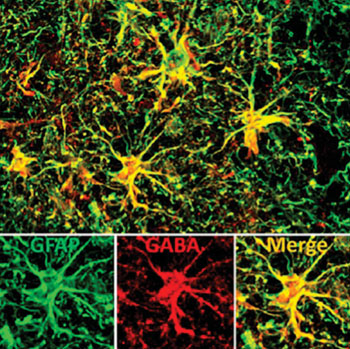High GABA Level Astrocytes Are a New Alzheimer's Disease Biomarker and Drug Target
By LabMedica International staff writers
Posted on 26 Jun 2014
Cells comprising an abnormal class of brain cells called reactive astrocytes contain high levels of the inhibitory neurotransmitter gamma-aminobutyric acid (GABA) and are being eyed by researchers as a potential biomarker and drug target for Alzheimer's disease (AD).Posted on 26 Jun 2014
Amyloid plaques and tau tangles are common pathological characteristics of AD. However, drugs designed to reduce production of the Abeta peptides that form amyloid plaques failed to relieve the symptoms of AD patients. Now, a paper published the June 13, 2014, online edition of the journal Nature Communications reported the presence of high GABA content in reactive astrocytes in the dentate gyrus (DG) of a mouse model for AD that resulted in increased tonic inhibition and memory deficit.

Image: This image shows a microscopic view of the high concentration (red) of gamma-aminobutyric acid (GABA) in the reactive astrocytes (green) in the human brain with Alzheimer\'s disease (Photo courtesy of Dr. Gong Chen, Pennsylvania State University).
Investigators at Pennsylvania State University (University Park, USA) also confirmed the presence of astrocytes with a high GABA content in human AD patient brains. This finding suggested that a high astrocytic GABA level may be a novel biomarker and a potential diagnostic tool for AD.
They also considered the possibility of developing drugs to target these high GABA level astrocytes after it was found that excessive GABA was released through an astrocyte-specific GABA transporter (GAT3/4).
"Our studies of AD mice showed that the high concentration of the GABA neurotransmitter in the reactive astrocytes of the dentate gyrus correlates with the animals' poor performance on tests of learning and memory," said senior author Dr. Gong Chen, professor of biology at Pennsylvania State University. "After we inhibited the astrocytic GABA transporter to reduce GABA inhibition in the brains of the AD mice, we found that they showed better memory capability than the control AD mice. We are very excited and encouraged by this result because it might explain why previous clinical trials failed by targeting amyloid plaques alone. One possible explanation is that while amyloid plaques may be reduced by targeting amyloid proteins, the other downstream alterations triggered by amyloid deposits, such as the excessive GABA inhibition discovered in our study, cannot be corrected by targeting amyloid proteins alone. Our studies suggest that reducing the excessive GABA inhibition to the neurons in the brain's dentate gyrus may lead to a novel therapy for Alzheimer's disease. An ultimate successful therapy may be a cocktail of compounds acting on several drug targets simultaneously."
Related Links:
Pennsylvania State University














